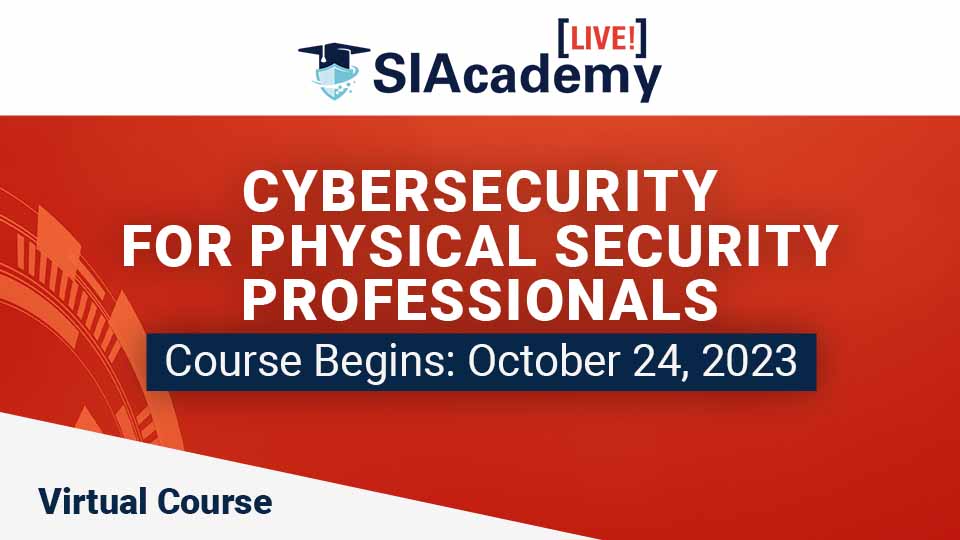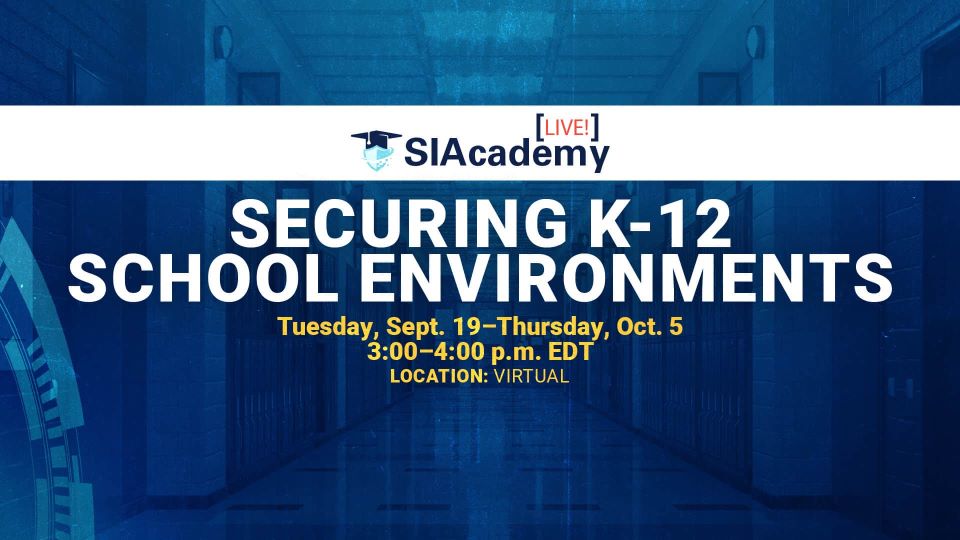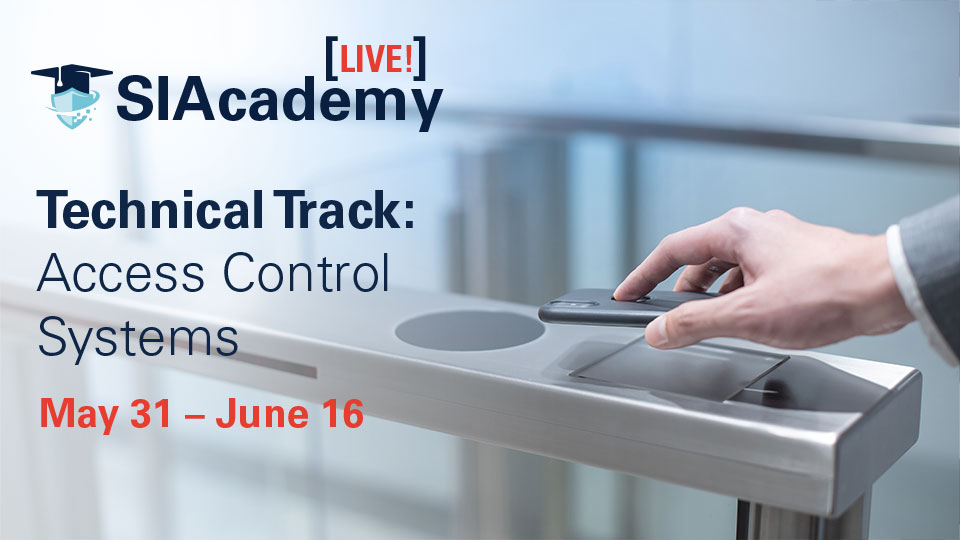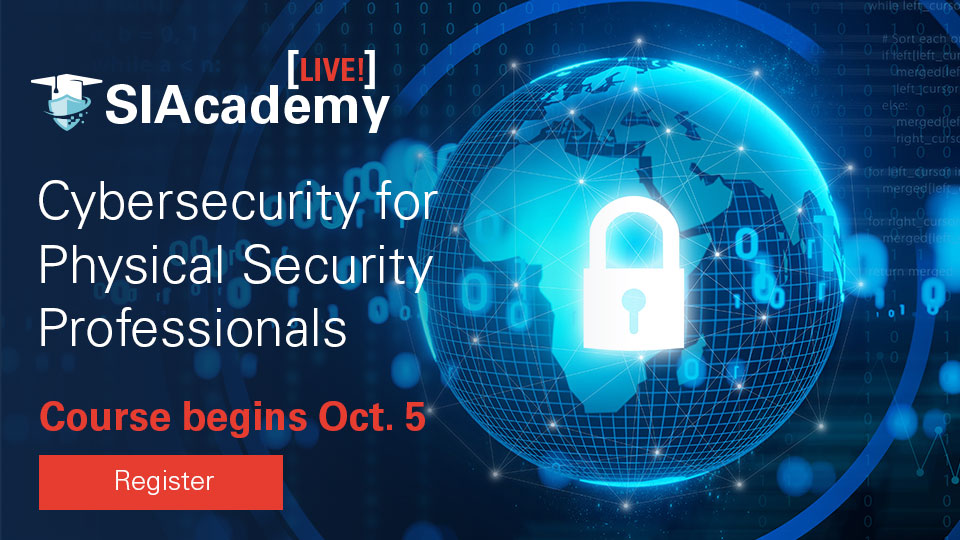
SIAcademy LIVE!
NEW! Instructor-Led Virtual Courses to Help You Grow Your Business and Technical Know-How
SIAcademy LIVE! e-learning programs are presented as tracks with 4-7 hours of training each. These live virtual courses are designed to accelerate your business growth, covering topics like how to do business with the government, how to optimize challenging parts of your integration business and cybersecurity for physical security pros and even technical training on video and access control systems.
The Basics
- Instructor-led live online programming: Just like SIA’s popular Security Project Management courses, our SIAcademy LIVE! programs are all led by SIA-selected expert instructors in a small-group type format (maximum class size is 25 students). Expect lots of interaction; come ready to ask questions, bring your problems and share collaboratively with other students.
- 4+ hours of training per course: You'll attend weekly classes covering important topics with each series.
- 100% virtual! Our e-learning format makes it convenient to fit this into your busy schedule.
- Missed a class? Don’t worry; all sessions will be recorded for your on-demand access.
- Certificate of Completion: Once you complete a series, you will receive an official SIA Certificate of Completion, attesting your knowledge in this area.
- SIA Center of Excellence quality content: Each SIAcademy LIVE! learning series is approved as SIA Center of Excellence content, ensuring it is thorough, vendor-neutral and highly informative.
More courses to be announced soon!
Purchase Access to SIAcademy LIVE! Learning Programs
- Individual Access: Purchase your access to a SIAcademy LIVE! series for just $199 ($199 for SIA members; nonmember rate is $249). Your ticket includes access to all sessions/dates within that course.
- Corporate Access Package: Purchase access to any SIAcademy LIVE! series for any 5 employees for just $699 ($699 for SIA members; nonmember corporate package is $899 for 5 employees).
Past Courses Available for On-Demand Access
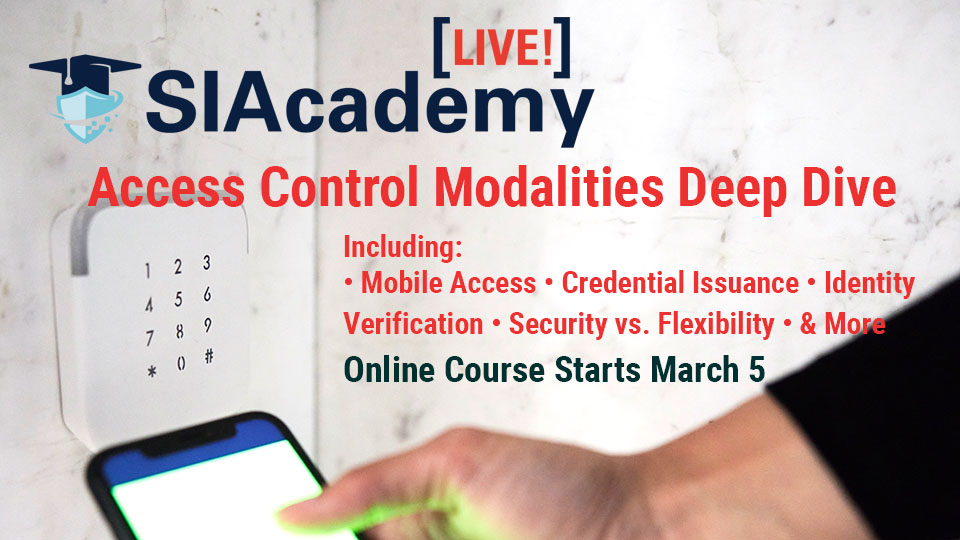 March 5-21, 2024 (Tuesdays and Thursdays)
March 5-21, 2024 (Tuesdays and Thursdays)
Expand your knowledge on identity, credential issuance, mobile access and how to select the right modality for your needs or that of your clients!
Contact education@securityindustry.org to inquire about corporate group pricing.
Course Description
Modalities in access control systems (ACS) encompass various technologies, systems and authentication methods which are quickly evolving. For this series, SIA has teamed up with Access Control Executive Brief to explore various types of ACS and their practical applications. Join moderator Lee Odess in this interactive learning series to further your understanding of multiple ACS modalities including mobile credentials. This series will provide you and your team with valuable ACS insights on applications and use cases for enhanced security and improved user experience.
Our goal is to provide a dynamic learning experience for busy professionals seeking continuous learning opportunities. We highly encourage participants to attend the live webinar sessions, engage in moderated discussions and ask questions to gain a deeper understanding of key concepts and real-world applications. Each instructor-led session in this series is recorded, and participants will receive on-demand access for 90 days.
This series is ideal for:
- Security integrators
- End users/security practitioners
- Security consultants and specifiers
- Project managers
- Technicians and installers
- Sales and marketing professionals who need to be knowledgeable on access control systems
Course Schedule
Session 1: The Current Landscape of Credentials and Modalities in Identity Verification (Tuesday, March 5, 3-4 p.m. EST)
Instructor: Troy Johnston, Director and Head of Mobile Strategic Alliances, HID Physical Access Control Systems Americas
Learning Objectives:
- Review the history of credentials and modalities
- Explore the various credentials and modalities currently in use
- Discuss the implications of these modalities on security and user experience
Session 2: The Process and Issuance of Modalities (Thursday, March 7, 3-4 p.m. EST)
Instructor: Lindsay Martin-Nez, CEO, BadgePass
Learning Objectives:
- Understand the process involved in the issuance of various modalities
- Learn about the benefits and challenges associated with the issuance of different modalities
- Discuss different vertical and application use cases
Session 3: The Evolution and Impact of Mobile as a Modality in Access Control (Tuesday, March 12, 3-4 p.m. EDT)
Instructor: Travis Willis, Product Manager for Switch Tech, dormakaba USA Inc.
Learning Objectives:
- Discuss the current state and future trends of mobile as a modality
- Evaluate and compare the advantages and challenges of mobile modality in access control
- Learn about the implications of mobile modality on security, user experience and technological innovation
Session 4: Mobile Modalities: Applications and Use Cases (Thursday, March 14, 3-4 p.m. EDT)
Instructor: Eric Brinks, Director of Business Development, Wavelynx
Learning Objectives:
- Uncover the diversified applications of mobile modalities in various sectors
- Analyze real-world use cases of mobile modalities in identity verification
- Discuss the impacts and potential challenges of mobile modalities in enhancing security measures
Session 5: Scaling Mobile Credential Implementations (Tuesday, March 19, 3-4 p.m. EDT)
Instructor: Brandon Arcement, Chief Commercial Officer, SwiftConnect
Learning Objectives:
- Understand the challenges and opportunities in scaling mobile implementations
- Learn about the best practices for successful large-scale implementation of mobile modalities
- Explore real-world case studies of scaled mobile implementations and their impact on security measures
Session 6: The Future of Identity, Credentialing and Modalities: A Glimpse Into Tomorrow's Authentication (Thursday March 21, 3-4 p.m. EDT)
Instructor: Kabir Maiga, CEO, Passive Bolt
Learning Objectives:
- Explore emerging trends and future direction of identity, credentialing and modalities
- Explain the technological advancements driving changes in the field of identity, credentialing and modalities
- Discuss the potential challenges and opportunities presented by these future modalities
Course Dates: Oct. 24, 26 and 31; Nov. 2, 7 and 9, 2023
Course Description
In this series, participants will learn about essential cybersecurity and networking subjects that are crucial for physical security professionals. Whether you are responsible for deploying and overseeing security solutions or require a solid grasp of these concepts for effective collaboration with partners and clients, this series of expert-led sessions has you covered.
The topics in this learning series address key concepts covered by the Security Industry Cybersecurity Certification (SICC) that will help you to enhance your cybersecurity knowledge, understand the cyber threat landscape, and become well-equipped to engage confidently in collaborative efforts, ensuring a higher level of security and competence in the physical security domain.
This series is ideal for:
- Technicians, installers and project managers
- IT directors, managers and tech support
- Security consultants
- Engineers (systems, application and IT), designers and integration specialists
- Sales and marketing professionals who need to be knowledgeable on customer networks and cybersecurity requirements
Contact education@securityindustry.org for discount code or to inquire about corporate group pricing.
To find out how to use PSA training bucks to register for this series, please contact edu@psasecurity.com.
Course Schedule
Session 1: Public Key Infrastructure (PKI) and Secure Network Communications (Tuesday Oct. 24, 3:00-4:00 p.m. EDT)
Instructor: Jim Cooper, Chief Technology Officer, Integrated Security & Communication
Learning Objectives:
- Explain the role of PKI in ensuring secure authentication, data confidentiality and data integrity in network communication within the physical security context
- Evaluate different use cases for various certificate types based on unique characteristics and specific functionalities
- Learn how to attach certificates to devices and services in a physical security deployment to establish a chain of trust
- Examine common security vulnerabilities related to PKI and network communication and discuss strategies to troubleshoot issues, detect potential breaches and implement countermeasures to enhance security and resilience
Session 2: How Vulnerable Is Juice Shop? A Secure Code Review of Insecure Code (Thursday Oct. 26, 3:00-4:00 p.m. EDT)
Instructor: Joshua Beck, Staff Application Security Engineer, John Deere
Learning Objectives:
- Examine insecure code and identify common vulnerabilities found in web applications through an interactive, gamified penetration testing demonstration focused on inputs
- Discover ways to efficiently test applications and recognize various web vulnerabilities without brute force
- Explain how to create secure code patterns for interoperable systems which are easy to implement and prevent common vulnerabilities
Session 3: Best Practices in Patch Management and Software Security (Tuesday Oct. 31, 3:00-4:00 p.m. EDT)
Instructor: Will Knehr, Senior Manager of Information Security and Data Privacy, i-PRO Americas
Learning Objectives:
- Explain the role of patch management in maintaining software security
- Analyze real-world examples where lack of patch management led to security vulnerabilities and breaches
- Describe the role of vulnerability assessments and penetration testing in supporting effective patch management
- Understand the process of testing and deploying patches, considering factors like scheduling, testing environments, roll-back plans and communication strategies
Session 4: Advanced Encryption Standards (Thursday Nov. 2, 3:00-4:00 p.m. EDT)
Instructor: Will Knehr, Senior Manager of Information Security and Data Privacy, i-PRO Americas
Learning Objectives:
- Recognize the challenges and requirements in the modern digital landscape that drive the need for evolving encryption standards
- Explain the principles behind symmetric, asymmetric and authenticated encryption standards and key exchange methods
- Analyze the implications of encryption choices in various contexts, such as Internet of Things devices, cloud storage and communication systems
- Discuss emerging trends and ethical, legal and policy considerations related to encryption
Session 5: Onboarding New Technicians and Installers: Upskilling Practices That Work (Tuesday Nov. 7, 3:00-4:00 EST)
Instructor: Jennifer Maines, Director of IT Operations, Life Safety Engineered Systems
Learning Objectives:
- Discuss effective approaches to knowledge management to reduce paperwork and streamline processes.
- Examine your onboarding and compliance training rules and procedures.
- Explore training opportunities offered through vendor apps and third-party providers.
Session 6: Defense in Depth and Common Attack Vectors (Thursday Nov. 9, 3:00-4:00 p.m. EST)
Instructor: Chris Peckham, Chief Operating Officer, Ollivier
Learning Objectives:
- Examine strategies in layers of defense to include network, perimeter, application, data and endpoint security.
- Analyze common system vulnerabilities and cyberattack techniques using case studies of real-world exploits
- Discuss best practices in secure network architecture and design to prevent cybersecurity incidents and breaches
Sept. 19, 21, 25, 2023; Oct. 3, 5, 2023
This Series Is Made Possible With Support From:





Course Description
This learning series examines the current state of K-12 school security and covers proactive security measures designed to enhance building and perimeter protection, secure classrooms and interior learning facilities, prevent active shooter incidents and enhance situational awareness. This series will also provide resources on the PASS Guidelines and potential grant funding opportunities for school safety and security improvement projects.
This series is ideal for:
- District and School Administrators/Staff
- School Resource Officers/Campus Law Enforcement
- Security Project Mangers
- Facility Architects/Engineers
- Integrators and Installers
- Security Consultants
- Nonprofit Representatives
Course Schedule
Session 1: The Current State of K-12 School Security (Tuesday, Sept. 19, 3:00- 4:00 p.m. EDT)
Instructor: Ryan Streeter, Product & Training Lead, CISA School Safety
Learning Objectives:
- Equip session participants with knowledge of the current K-12 threat and risk environment facing school safety systems.
- Provide session participants with the knowledge to assess their school’s current threat environment or protection measures, and how those work together to reduce risks.
- Inspire session participants to identify areas for improvement in their school safety plans and empower them to take action to address any deficiencies.
Session 2: Secure the Perimeter, Protect the Interior (Thursday, Sept. 21, 3:00-4:00 p.m. EDT)
Instructor: Chris Gisslen, Director of Business Development- K12, ASSA ABLOY Door Security Solutions
Learning Objectives:
- Learn how to perform door surveys to enhance building and classroom security.
- Discuss best practices around key control and door schedules to prevent unauthorized access.
- Discuss operational policies and procedures to empower teachers, administrators, and students.
Session 3: Proactive Security Measures for Active Shooter Scenarios (Tuesday, Sept. 26, 3:00-4:00 p.m. EDT)
Instructor: Kieran Carroll, Chief Strategy Officer, ZeroEyes
Learning Objectives:
- Learn how to leverage existing camera infrastructure to deploy proactive firearm detection analytics.
- Discuss best practices surrounding the integration of weapons detection technology into emergency action plans and the security strategy at K-12 schools.
- Review evaluation criteria to inform purchasing decisions and identify potential funding opportunities.
Session 4: Leveraging Video Surveillance to Enhance School Security (Thursday, Sept. 28, 3:00-4:00 p.m. EDT)
Instructor: James Marcella, Director, Industry Associations, Axis Communications
Learning Objectives:
- Discover how schools are leveraging the four fundamental use cases for video surveillance to create safe learning spaces.
- Discuss best practices, as defined by the PASS K12 Guidelines, for deploying video surveillance in layers of protection from district-wide measures to facility-specific use cases.
- Define operational requirements for the effective use of video surveillance during active assailant or other emergency situations.
Session 5: School Doors & Locks 101 – Learnings from Uvalde and Previous Attacks (Tuesday, Oct. 3, 3:00-4:00 p.m. EDT)
Instructor: Ken Cook, BSME, MBA, CPD, CE, Director of National School Safety and Advocacy, Allegion
Learning Objectives:
- Examine previous school shooting incidents and apply lessons learned to help prevent future attacks.
- Discuss perimeter door safety, classroom door safety as well as connecting doors and understand the importance of compartmentalization for increased security.
- Learn more about taking a “layered security” approach and applying the best practices for securing school doors based on the incident commission reports.
Session 6: Planning for School Security Improvement Projects (Thursday, Oct. 5, 3:00-4:00 p.m. EDT)
Instructor: Mark Schreiber, President & Principal Consultant, Safeguards Consulting, Inc.
Learning Objectives:
- Gain insights into the security improvement planning process for physical security system upgrades and other renovations from a risk-based perspective.
- Discuss the importance of stakeholder involvement and effective communication throughout the upgrade process and understand how to foster collaboration among different teams and departments.
- Discover key considerations to maximize investments in preventative measures to enhance school safety and security.
SERIES Available Soon FOR ON-DEMAND, SELF-DIRECTED LEARNING
Course Description
In this technical learning series, we cover essential aspects of digital identity, access management and systems integration. Learn about the move to mobile credentialing and how the evolution of property technology (proptech) is reimagining security with the user experience at the forefront. This course provides technical insights on artificial intelligence and biometrics technology and cloud-based access control models and explores the role Web3 plays in the next generation of access and identity management solutions.
This series is ideal for:
- Dealers/installers/integrators
- Project managers
- Security consultants
- Customer success managers/sales teams
- Engineers (systems, application and IT), designers and integration specialists
- Security sales engineers and account managers who need to be knowledgeable about video security system operations and applications
Course Schedule
Session 1: Cloud Access Control and the Importance of API Integrations
Instructor: Mike Maxsenti, general manager, access control, Genea
Learning Objectives:
- Discover why many IT and security teams are replacing on-premises access control systems with cloud-based solutions
- Discuss how API integrations between access control, video surveillance and identity management are helping organizations save time and cut costs
- Identify what organizations should look for when considering a cloud-based access control provider
Session 2: The Move to Mobile
Instructor: Robert Lydic, president, Wavelynx
Learning Objectives:
- Learn about the rapid advancement of mobile access control and mobile credentials as a viable and efficient technology solution
- Understand how to create an outstanding customer experience by learning what challenges are facing end users today and how meeting these needs is critical to mobile gaining adoption
- Learn how companies can leverage mobile technology to create a seamless and unified user experience
Session 3: Proptech Explained
Instructor: Lee Odess, CEO, Access Control Executive Brief
Learning Objectives:
- Understand what proptech is
- Understand why it matters
- Learn what you can do about it
Session 4: Why Access Control Professionals Need to Move From Wiegand to OSDP
Instructor: Rodney Thayer, consultant, Smithee Solutions LLC
Learning Objectives:
- Learn how to align access control solutions with modern information security requirements
- Become prepared for client demands for access control add-on solutions that require more sophisticated door access offerings
- Identify ways to evolve your technical approach to leverage industrial Internet of Things solutions
Session 5: Decentralized Identity and Web3-Based Access Control
Instructor: Kabir Maiga, co-founder and CEO, PassiveBolt
Learning Objectives:
- Learn about Web3 technology and cryptographic credentials
- Discuss how decentralized digital identity has the potential to disrupt the security industry
- Identify opportunities for new Web3 applications in the security industry
Session 6: Credential Interoperability, Mixing Manufacturers
Instructor: Jim Cooper, Chief Technology Officer, Integrated Security & Communications
Learning Objectives:
- Review different smart card technologies and their applications for physical access control systems
- Discuss secure data storage and interoperability requirements among different reader manufacturers
- Address challenges of multiple technologies within a multi-tenant building
SERIES Available Soon FOR ON-DEMAND, SELF-DIRECTED LEARNING
Course Schedule
Session 1: The Importance and Impact of Virtualization on Physical Security
Instructor:
- Darren Giacomini, director of business development, advanced systems, BCD
Learning Objectives:
- Describe what distinguishes virtual architecture from other forms of video surveillance architecture, as well as define the best use case scenarios for implementation
- Discuss the impact virtualization has on the physical security industry in terms of TCO, resource consumption, usability and other facets
- Identify crucial aspects of implementation and design for virtualized systems and how it differs from designing and implementing traditional infrastructures
Session 2: Designing and Deploying Video Networks With Customer IT Departments
Instructor:
- Jim Cooper, systems engineer, ADC2S at Amazon Web Services
Learning Objectives:
- Learn how to effectively with customer IT departments on designing and deploying video networks
- Discuss appropriate cybersecurity controls for video systems, both on-premises and cloud
- Review reasonable expectations to discuss with the customer during system design phase to ensure deliverables are met
Session 3: Video Surveillance in Smart Cities – An Integrated Approach
Instructor: Kevin Taylor, segment development manager, smart cities, Axis Communications
Learning Objectives:
- Discuss the current state of smart-cities and the role of video technology
- Leveraging integration capabilities to enhance video system deployment
- Consulting with end-users to identify needs, evaluate capabilities and select products based on intended use
- Explore the future smart-city landscape – what is coming in 2023 and beyond?
Session 4: Understanding Deep Learning and AI Capabilities for Next-Gen Video Analytics
Instructor:
- Matthew Cirnigliaro, regional marketing manager – video analytics, Bosch Security and Safety Systems
Learning Objectives:
- Explain how deep learning is opening new possibilities for video-based detection and data solutions
- Understand that AI-driven video analytics can transform a task from requiring human input to a successfully automated one and tackle more complex tasks faster, easier, and with greater accuracy
- Share examples of how AI-driven video analytics can be used in a variety of industries and to solve common pain points
Session 5: Video Surveillance as a Service: Architecture, Best Practices, and Use Cases
Instructor:
- Michael Sherwood, vice president, customer experience, Arcules
Learning Objectives: In this session, we will cover what video surveillance as a service is, how it works, use cases and important considerations.
- Gain a full understanding of the various VSaaS and cloud architectures and the advantages and disadvantages of each
- Know when to choose VSaaS over on-premises and vice versa
- Understand the most common customer problems that are solved with VSaaS
- Learn about emerging technologies and how to align with VSaaS vendors that are best suited to take advantage
Session 6: The Ethical Use of Video Surveillance Data and Analytics
Instructors:
- Teresa Wu, vice president, smart credentials, IDEMIA
- Sal D'Agostino, founder, IDmachines; co-founder, OpenConsent
Learning Objectives:
- Review and discuss video use cases that raise ethical and privacy concerns
- Gain a better understanding of the financial, reputational and legal risks related to improper uses of video surveillance
- Learn about industry best practices for video and facial recognition deployment
- Become familiar with and take advantage of SIA resources to help navigate critical ethics and privacy considerations
SERIES AVAILABLE Soon FOR ON-DEMAND, SELF-DIRECTED LEARNING
Course Schedule
Session 1: Physical and Cybersecurity Conversion Challenges
Instructor: Patrick Simon, president and manager, Beehive Technology Solutions
Session 2: Visual AI Solutions for Critical Infrastructure
Instructor: Paul Sun, president and CEO, IronYun
Session 3: Future-Proofing Critical Infrastructure Security
Instructor: Jasvir Gill, CEO, AlertEnterprise
Session 4: Critical Infrastructure and Interdependencies
Instructor: Anthony Hurley, partner/consultant, Critical Preparedness, LLC
Session 5: Risk Management in Critical Infrastructure
Instructor: David Lathrop, president, PSB Exero
Session 6: Demystifying Critical Infrastructure Security
Instructor: Pierre Bourgeix, senior partner and co-founder, ESI Convergent
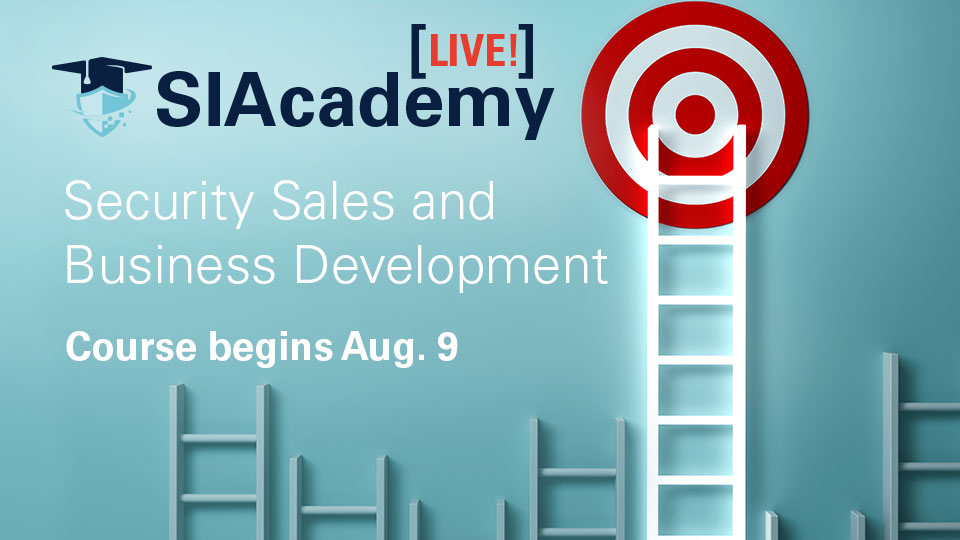 About the Course
About the Course
This learning series is designed for security professionals at manufacturer, integrator, dealer and reseller businesses who are looking to increase sales, improve lead generation strategies and win more business through authentic customer service and needs-based sales approaches.
This series is ideal for:
- Sales leaders at systems integration/installing/reseller/dealer firms
- Manufacturer business development and account representatives
- New and rising employees seeking insights on sales and business growth strategies
- Sales, marketing and operations professionals looking to enhance customer service and executive skills
Course Schedule
Session 1: Security Sales and Business Development Strategies
Moderator: Kasia Hanson, global IoT video sales director, safety and security, Intel
Panelists:
- Maria Cambria, vice president, sales enablement – solutions, Teledyne FLIR
- Kelsey Carnell, regional sales manager, Axis Communications
- Stephanie Mayes, vice president of sales, SiteOwl
Learning Objectives:
- Identify resources and tactical strategies to succeed in security sales and business development
- Learn to effectively leverage an adaptive sales approach to gain more customers in a competitive, post-pandemic marketplace
- Discuss how versatile sales styles increase your credibility and contribute to positive customer relationships
- Learn why active listening is one of the most important skills in sales that can help you save valuable time
Session 2: Security Sales – A Consultative Approach
Instructor: Pierre Bourgeix, senior partner and co-founder, butchko-esi
Learning Objectives:
- Learn how a "centers of influence" approach to selling can boost your market access and build credibility
- Discuss procedures for assessing and evaluating the needs of a customer based upon objective, risk and capabilities
- Develop strategic, bilateral relationships to address customer needs while building trust within the industry
Session 3: The Art of Upselling
Instructor: Maureen Bruen, senior demand generation manager, Honeywell
Learning Objectives:
- Discover how the practice of “upselling” can generate greater revenue and increase value for your customers
- Examine the differences between upselling and cross-selling and develop a strategic sales approach to enhance the customer's use and experience
- Discuss examples of how to succeed in upselling though marketing promotions, ecommerce and email communications
Session 4: Proposals and Presentations That Separate You From the Competition
Instructors:
- Janet Fenner, president, Defined Marketing
- Tracy Larson, president, WeSuite
Learning Objectives:
- Relate the importance of sales proposals and presentations to winning new deals and creating a competitive advantage
- Identify key elements within your company's existing proposal document to change and improve in the next 60 days – and why
- Learn to differentiate you and your company while delivering a "customer-first" presentation approach
Session 5: Selling to the CISO
Instructor: Dave Tyson, president, Apollo Information Systems
Learning Objectives:
- Examine the intricacies and differences in selling to chief information security officers (CISOs) and IT leaders and learn how to get the first meeting
- Discuss best practices in customer profiling for cybersecurity leaders’ business development
- Review research results on how CISOs and cyber leaders want to be contacted
Session 6: The Value of Coopetition Within the Security Sales Ecosystem
Instructor: Colin DePree, sales strategy, North America, SALTO Systems
Learning Objectives:
- Learn how partners and even competitors can help you to increase sales and generate more business
- Discover how to balance competition and brand protection while leveraging partnerships to meet clients’ needs
- Create value and build trust with clients through a collaborative, needs-based approach to sales
Session 7: Selling Security Systems in the 2020s
Instructor: Chris Peterson, founder and president, Vector Firm
Learning Objectives:
- Develop a full understanding of the evolution of the buying process and how it impacts selling security systems
- Discuss the current state of prospecting and where the practice is heading
- Learn to lead conversations that will be more meaningful for your customers
- Discover how to use new and some not-so-new interpersonal skills to differentiate yourself
SERIES NOW AVAILABLE FOR ON-DEMAND, SELF-DIRECTED LEARNING
SIAcademy LIVE Technical Tracks are practical series for integrator employees and hands-on field teams for practitioners. These course series are designed to strengthen your technical proficiency and learn full considerations related to implementing security systems.
Ideal for:
- Technicians and project managers at systems integration firms and professional services teams
- Security practitioner teams managing electronic security solutions
- New and rising employees seeking additional learning on electronic security solutions
- Sales, marketing and development professionals that need additional technical training
Access Control Systems Technical Track
Covers these important topics:
- Fundamentals: Common systems designs and hardware used in access control
- Credentials and credential management
- Readers and controllers
- Access control software system functionality and common features
- Common system designs, including cloud solutions
- Integrating access control with other security systems
- Essential codes for common building access and egress
Course Schedule
Session 1: Essential Codes for Common Building Access and Egress
Instructor: Rodger Schmidt, technical trainer, Electromechanical Solutions Group, ASSA ABLOY
Learning Objectives:
- Identify where to find applicable code sections in IBC and NFPA Codes online.
- Explain the basics of electronic locking hardware codes
- Understand the importance of the site survey with the occupancy, load and egress in mind when looking to access control a facility
- Discuss the basics for access control doors setup up for delayed egress, controlled egress, maglocks, stairwell and elevator lobbies
Session 2: Mitigating Vulnerabilities With Integrated Access Control Solutions
Instructors:
- Justin Scheitlin, vice president, chief information security officer, Allegion
- Robert Gaulden, go to market director, multifamily access, Allegion
Learning Objectives:
- Explore the changing landscape for an integrator in an increasingly cloud-native and API-connected world
- Discuss methods used to safeguard assets within a client’s environment and protect their business from natural or manmade threats
- Review operational controls and best practices to secure physical locations where information systems and physical equipment is located
Session 3: Intelligent Access Management: The Value of the End-User Experience
Instructor: Jon Harris, business vision and strategy, Latch
Learning Objectives:
- Discuss the perspective of the end-user as a building occupant
- Explore the influence of organizational culture on the effectiveness of access controls
- Discover the hidden operational value of access control for end users
- Learn about “enablement” features of intelligent access control systems
Session 4: Credentials and Credential Management
Instructor: Jeremy Massiet, product manager, IDEMIA
Learning Objectives:
- Define what a credential is and describe its purpose with the access control system
- Review various types of credentials and how they work
- Learn about combination credentials and multifactor authentication
- Discuss methods or controls to provision user access levels based upon the principle of “Least Privilege"
Session 5: Common Systems Designs and Hardware Used in Access Control
Instructors:
- Marcus Batten, national security consultant, Allegion
- Jeff Bransfield, regional sales manager, American Digital Security
- Brian Coulombe, senior manager of physical security, Americas, Amazon
- Derek Ommert, PSP, vice president, Protus3
Learning Objectives:
- Learn about common components, products and software applications for access control systems
- Discuss basic biometrics technology, measurement techniques and digital forensics
- Identify common incompatibilities and limitations in access control systems technology
Session 6: An Introduction to OSDP Protocols: Understanding Readers and Controllers
Instructor: Esteban Pastor, product manager, ZKTeco USA
Learning Objectives:
- Discuss basic serial communication standards and protocols
- Describe the security benefits and advanced functionality of OSDP
- Identify common security devices that are OSDP compatible
Learning Levels: Fundamentals, Intermediate
SERIES NOW AVAILABLE FOR ON-DEMAND, SELF-DIRECTED LEARNING
Course Description
In this technical learning series, we cover essential aspects of video surveillance systems as an integrated security solution. Learn about basic camera systems design, functionality and deployment and take a deep dive into device hardening, video authentication and data protection for hardwired and networked video equipment. By taking this course, you will learn about the tools and methods used to safeguard critical information (data) and be able to advise customers on video system solutions based upon intended use, system requirements and operational controls.
Best of all, this course series aligns with key areas tested by the new Security Industry Cybersecurity Certification (SICC). By taking this course, you will learn key concepts that are covered on the SICC exam in device security, network communications security and information security principles.
This series is ideal for:
- System installation technicians
- Project managers
- Quality technicians
- Engineers (systems, application and IT) designers, and integration specialists
- Security sales engineers and account managers who need to be knowledgeable on video security system operations and applications
Registration
Registration for this course series is $149/$199 (SIA members save $50). Your registration includes on-demand, self-directed access to all course sessions. A 5-seat corporate registration package is $499/$699 (SIA members save $200) and includes registration for five individuals from your company.
Session Descriptions
Session 1: Fundamentals: Common Systems Designs and Hardware Used in Video Surveillance
Instructor: Izzy Sharif, senior solutions trainer, Axis Communications
Learning Objectives:
- Review the primary components and basic operations of digital video surveillance systems
- Understand the basic requirements for each component to produce usable data (information)
- Learn to recognize variables and understand their effect on the final product (video)
Session 2: Basic Operations of Video Surveillance Systems and Integrated Security Solutions
Instructor: Jim Cooper, vice president of technology, Integrated Security & Communications
Learning Objectives:
- Review common network connected edge devices in a security installation
- Identify backup tools used to safeguard critical resources and monitor activity (software and hardware)
- Discuss testing protocols, settings configuration and hardening processes
- Learn about the National Electric Code (NEC) and other common requirements that affect device installation and configuration
Session 3: Protecting Video Management Systems (VMS) and Customer Data in Any Environment
Instructor: David Brent, senior cyber and data security technical instructor, Bosch Security and Safety Systems
Learning Objectives:
- Discuss basic principles of network security systems and data security within a client's environment (e.g., cloud, on premises, off premises, hybrid)
- TLS and PKI
- Explain security system communication protocols and data encryption protocols and techniques
- Examine different processes for video authentication and how it affects admissibility
Session 4: Fundamentals of Networking and Cabling
Instructor: Darren Giacomini, director of business development, advanced systems, BCD
Learning Objectives:
- Review basic concepts of Layer 2 and Layer 3 networking
- Learn how to design a network for scalability and build appropriate network segmentation into your project
- Discuss key concepts of broadcast, unicast and multicast transmission
- Review basic troubleshooting concepts for physical security networks
Session 5: Challenging Video Scenarios: How to Select the Right Camera Type for the Application
Instructor: Izzy Sharif, senior solutions trainer, Axis Communications
Learning Objectives:
- Discuss principles and methods for determining the objective of a video surveillance system
- Learn what questions to ask to identify and evaluate the operative conditions of the system
- Become familiar with the information in the datasheets and how to read them
- Take advantage of computerized tools to assist you in the process
Session 6: Reliable and Secure Cloud, Mobile and Wireless Services for Video Security Systems and IoT Devices
Instructor: Steve Lindsey, Chief Technology Officer, LiveView Technologies
Learning Objectives:
- Learn about wireless connectivity challenges and how to overcome them.
- Consider the management, health, and uptime of wireless connected IoT devices.
- Discuss secure network architecture concepts for security systems design to include cloud, mobile and wireless applications.
- Explain network wireless security standards and protocols.
- Examine vulnerabilities of mobile devices and learn how to mitigate them.
This Course Is Supported By:
- Axis Communications
- BCDVideo
- Bosch
- Integrated Security & Communications
 SERIES NOW AVAILABLE FOR ON-DEMAND, SELF-DIRECTED LEARNING
SERIES NOW AVAILABLE FOR ON-DEMAND, SELF-DIRECTED LEARNING
This series of training sessions is for leaders and managers at integration/installing/reseller businesses who are looking to streamline operations within their firms and simultaneously win more business.
This series is ideal for:
- Systems integration business owners/leaders/directors
- Sales leaders at systems integration/installing/reseller/dealer firms
- Operations directors seeking to improve internal processes
- Any managers looking to grow business strategy and executive skills
These six training sessions will cover the following topics:
- Creating Competitive Advantage: From Site Assessments to Install and Everything In Between
- Instructor: Elisa Mula, founder, EMD, LLC
- Session learning objectives:
- Discover the benefits of offering a consultative approach to client relationships.
- Understand the value of cultivating partnerships to create competitive advantage.
- Discuss opportunities in fundraising/grants and assessments.
Identify new potential revenue streams as an integrator. - Share strategies for remaining agile during transformative times.
- Best Practices for Successful Security Design Projects
- Instructor: Frank Pisciotta, president, Business Protection Specialists Inc.
- Session learning objectives:
- Identify and review common mistakes made by security consultants, integrators and end users.
- Explain and discuss solutions to these common mistakes to ensure a harmonious relationship among project stakeholders.
- Learn how effective coordination, communication and commitment can lead to increased profit margins for integrators.
- How to Position Your Company for Success in Today’s Competitive Business Landscape
- Instructor: Kirk MacDowell, president, MacGuard Security Advisors Inc.
- Session learning objectives:
- Examine what mega-tech security companies are doing to establish competitive advantage and learn their keys to success.
- Discover what new technologies can help optimize your business operations and learn how to leverage technological innovation.
- Review your marketing strategy to align with the diverse needs and wants of customers.
- Customize your selling approach to changing dynamics of commercial and multi-family residential security.
- Common Project Profitability Killers and Effective Project Management
- Instructors: John Nemerofsky, chief operating officer, Sage Integration; Brendan McFall, technical engineering manager, Northland Controls
- Session learning objectives:
- Discuss best practices to avoid common profit killers in integration projects as a business leader.
- Share lessons learned from foreseeable and unforeseeable disruptions that may impact the project's bottom line.
- Review key principles for effective security project management.
- Identify opportunities to improve project planning, monitoring, management and close to deliver project on time and within budget.
- Technology As-A-Service 101: Top 5 Misconceptions & Objections When Selling Technology As-A-Service
- Instructor: Scott Morgan, business development, TAMCO
- Session learning objectives:
- Remove the confusion about interest rate associated with financing and as-a-service solutions
- Determine if technology solutions are good investments for your customers
- Explore whether using net profits for technology solutions is financially responsible
- Rethink the logic of a CAPEX/ownership purchase of technology solutions
- Business Optimization: Creating a Culture of Continuous Improvement
- Instructor: Jon Laing, director of training and development, ASSA ABLOY
- Session learning objectives:
- Identify opportunities for improvement within your organization to optimize business processes.
- Describe clear, identifiable business goals to increase productivity and measure success along the way.
- Discuss core LEAN topics to improve operational efficiency.
- Learn how to lead organizational change by establishing a cycle of continuous improvement.
- Description: This hands-on, interactive workshop is designed to help integration business leaders manage change to optimize their work processes. Participants are required to complete a self-analysis tool which becomes a road map to help drive a culture of continuous improvement.
Learning Levels: Intermediate, Advanced
SERIES NOW AVAILABLE FOR ON-DEMAND, SELF-DIRECTED LEARNING
If you are seeking to create or expand your government business, this series is for you! It is particularly relevant for security industry systems integrators, manufacturers and any company developing products or providing services with government applications. This series will rely on SIA’s extensive knowledge of government agencies, programs, procedures and opportunities to help your business find growth in this market segment.
This course is ideal for:
- Executive leadership seeking government business growth
- Business development professionals working with government clients
- Product managers and other manufacturer employees creating solutions targeted for government applications
- Systems integrators and service providers seeking to expand government business
These six training sessions will cover the following topics:
- Doing Business With the Government: Getting Started and Identifying Project Opportunities
- Instructor: Shenê Commodore, government contracts and business manager, Intertek
- Identifying Applicable Federal and State Grants Programs
- Instructor: Jake Parker, senior director, government relations, SIA
- State and Federal Contracting
- Instructor: Rachel Wyatt-Swanson, director, federal enterprise solutions, VIRSIG LLC
- Leveraging the GSA Schedules Program
- Instructor: Lynn de Séve, president, GSA Schedules, Inc.
- Guidance on Buy America/Buy American Requirements
- Instructor: Dismas Locaria, partner, Venable LLP
- Cybersecurity Certifications Required for Government Partners
- Instructor: Andrew Lanning, co-founder, Integrated Security Technologies
Learning Levels: Intermediate, Advanced
SERIES NOW AVAILABLE FOR ON-DEMAND, SELF-DIRECTED LEARNING
Produced in Partnership With:

In this series of learning sessions, we cover some of the most important cybersecurity and networking topics that physical security professionals must be competent in, whether you’re installing and managing solutions or simply need proficiency and common knowledge when working with partners and clients.
Best of all, this course series aligns with topics tested by the new Security Industry Cybersecurity Certification (SICC). By taking this course, you will learn key concepts that are covered on the SICC exam such as device security, software assurance, information security principles and more!
This series is ideal for:
- Technicians, installers, and project managers
- IT directors, managers, and tech support
- Engineers (systems, application & IT), designers and integration specialists
- Sales and marketing professionals who need to be knowledgeable on customer networks and cybersecurity requirements
Covering these important topics:
- Basic Networking Knowledge and Information Security Principles
- Network Hardware and Device Security
- Network Communications Security
- Installation and Configuration
- Software Assurance and Security
- Operations Standards, Policies and Risk Assessments
Registration
Registration for this course series is $149/$199 (SIA members save $50). Your registration includes all course sessions via e-learning. A 5-seat corporate registration package is $499/$699 (SIA members save $200) and includes registration for five individuals from your company.
Course Schedule, Instructors and Objectives:
Understanding Documentation and Specifications
Instructors: Ray Coulombe, Managing Director, Security Specifiers; and Brian Coulombe, Principal, Director of Operations at Ross & Baruzzini
SICC domain covered: Installation and Configuration
Session learning objectives:
- Understand the key elements of The Construction Specifications Institute (CSI) MasterFormat, why it’s relevant and the divisions that may impact security projects
- Understand the role of a security designer/specifier and explain the relationship between consultants and integrators
- Identify the components of a construction documentation package as they may impact an installer and important features and symbols contained within
Device Security for Cyber Hardened Electronic Technology
Instructor: Josh Cummings, Vice President, Technology, VTI Security
SICC domain covered: Device security
Session learning objectives:
- Examine common network connected edge devices testing protocols, settings configuration, and hardening
- Explain the importance of disabling unused ports, protocols, and services in an edge device.
- Review password provisioning and management based on the principle of “Least Privilege.”
- Discuss principles surrounding the essentialness of physical hardening network devices, servers, and equipment
An Overview of Fundamental Information Security Principles
Instructor: Rich Campbell, Professional Services Engineer, RFI
SICC domain covered: Information security principles
Session learning objectives:
- Describe basic IT infrastructure and review maintenance requirements for operating systems and firmware related to physical security
- Classify threats to networked security system information security and identify common vulnerabilities of networked security systems
- Discuss fundamental defensive measures to protect information, information systems, and networks from threats
- Discover how physical security supports information security
Identifying and Protecting Against Physical Security System Vulnerabilities
Instructor: Chris Peckham, Chief Operating Officer, Ollivier
SICC domain covered: Operational standards, policies and risk assessment
Session learning objectives:
- Learn about operational and technical security controls and how they work
- Discuss how to implement security controls to protect an organization’s information assets from natural or man-made threats
- Determine how to assess risk, identify vulnerabilities, and advise on potential mitigations of physical security systems
- Identify backup tools used to safeguard critical resources and monitor activity (software and hardware)
Attack-o-nomics: Securing Physical Security Systems, Data and Applications
Instructor: Jody Booth, Security Champion, Vision Products, Intel
SICC domain covered: Software assurance and security
Session learning objectives:
- Discuss the current cyber threat landscape surrounding physical security systems
- Review the assets that need to be protected
- Learn about various types of computer malware, ransomware, and different attack vectors on a network
- Understand the depth of impact computer hacks and malware can pose to your organization
- Review device security tools, best practices, and procedures to safeguard against virus attacks
Technical Project Management for System Installations
Instructor: Brendan McFall, Technical Engineering Manager, Northland Controls
SICC domain covered: Project management and problem solving
Session learning objectives:
- Discuss key aspects of project planning and initiation including defining a scope of work and distinguishing the tasks covered in it
- Learn to interpret plans or blueprints and identify the location of devices within security design documents
- Review key points of information that should be communicated to project managers and Application Engineers during a project
- Share examples of various hazards that may occur during and after a task of work
Learning Levels: Intermediate, Advanced


